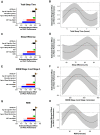Sleep and longitudinal cognitive performance in preclinical and early symptomatic Alzheimer's disease
- PMID: 34668959
- PMCID: PMC8536939
- DOI: 10.1093/brain/awab272
Sleep and longitudinal cognitive performance in preclinical and early symptomatic Alzheimer's disease
Abstract
Sleep monitoring may provide markers for future Alzheimer's disease; however, the relationship between sleep and cognitive function in preclinical and early symptomatic Alzheimer's disease is not well understood. Multiple studies have associated short and long sleep times with future cognitive impairment. Since sleep and the risk of Alzheimer's disease change with age, a greater understanding of how the relationship between sleep and cognition changes over time is needed. In this study, we hypothesized that longitudinal changes in cognitive function will have a non-linear relationship with total sleep time, time spent in non-REM and REM sleep, sleep efficiency and non-REM slow wave activity. To test this hypothesis, we monitored sleep-wake activity over 4-6 nights in 100 participants who underwent standardized cognitive testing longitudinally, APOE genotyping, and measurement of Alzheimer's disease biomarkers, total tau and amyloid-β42 in the CSF. To assess cognitive function, individuals completed a neuropsychological testing battery at each clinical visit that included the Free and Cued Selective Reminding test, the Logical Memory Delayed Recall assessment, the Digit Symbol Substitution test and the Mini-Mental State Examination. Performance on each of these four tests was Z-scored within the cohort and averaged to calculate a preclinical Alzheimer cognitive composite score. We estimated the effect of cross-sectional sleep parameters on longitudinal cognitive performance using generalized additive mixed effects models. Generalized additive models allow for non-parametric and non-linear model fitting and are simply generalized linear mixed effects models; however, the linear predictors are not constant values but rather a sum of spline fits. We found that longitudinal changes in cognitive function measured by the cognitive composite decreased at low and high values of total sleep time (P < 0.001), time in non-REM (P < 0.001) and REM sleep (P < 0.001), sleep efficiency (P < 0.01) and <1 Hz and 1-4.5 Hz non-REM slow wave activity (P < 0.001) even after adjusting for age, CSF total tau/amyloid-β42 ratio, APOE ε4 carrier status, years of education and sex. Cognitive function was stable over time within a middle range of total sleep time, time in non-REM and REM sleep and <1 Hz slow wave activity, suggesting that certain levels of sleep are important for maintaining cognitive function. Although longitudinal and interventional studies are needed, diagnosing and treating sleep disturbances to optimize sleep time and slow wave activity may have a stabilizing effect on cognition in preclinical or early symptomatic Alzheimer's disease.
Keywords: Alzheimer’s disease; EEG; biomarkers; memory; mild cognitive impairment.
© The Author(s) (2021). Published by Oxford University Press on behalf of the Guarantors of Brain. All rights reserved. For permissions, please email: journals.permissions@oup.com.
Figures




Comment in
-
Sleep and future cognitive decline.Brain. 2021 Oct 22;144(9):2568-2570. doi: 10.1093/brain/awab315. Brain. 2021. PMID: 34687209 Free PMC article.
References
-
- Fagan AM, Mintun MA, Mach RH, et al. Inverse relation between in vivo amyloid imaging load and cerebrospinal fluid Amyloid-beta-42 in humans. Ann Neurol. 2006;59(3):512–519. - PubMed
Publication types
MeSH terms
Grants and funding
LinkOut - more resources
Full Text Sources
Medical
Miscellaneous

